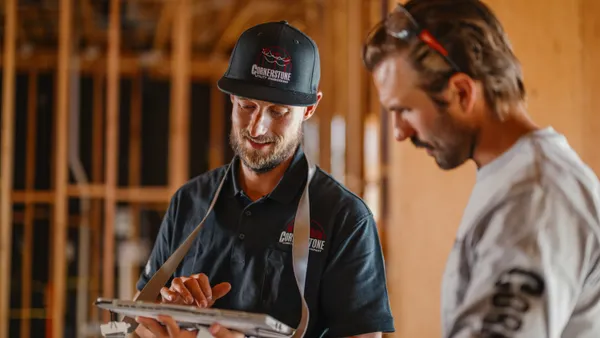Technologies like BIM, drones, virtual reality and real-time workflow software have made an entrance that will forever alter the scope of the construction industry. Every few weeks, Construction Dive provides a roundup of the latest technology product announcements that promise to boost productivity by saving contractors time, money and labor. To view the entire series, click here.
Dozer simulator from CM Labs breaks ground
A newly launched virtual dozer training platform from CM Labs has been designed to simulate the feeling of pushing soil and aggregate material, the Montreal, Canada-based company announced today.
The package is part of CM Labs’ Vortex simulators, and can be run from a single platform — which comprises a seat, system of screens, gear controls and software — just like its other crane and earthmoving tools such as its excavator package, which was also recently launched.
CM Labs said its dozer training solution is unlike other virtual training packages because it incorporates the dynamism of real physics rather than relying on pre-programmed computer-scripted scenarios.
“The realism is based on the training solution’s unique ability to engage a simulated transmission and engine the moment the virtual blade touches virtual soil,” the firm said in a press release. “Many simulators treat machine behavior as a kind of special effect that’s scripted into a training session,” said Drew Carruthers, CM Labs’ construction line manager. “This results in unrealistic performance and overconfident trainees.”
“The exercises that are built into the Dozer Training Pack are designed to address common beginner challenges such as setting the blade angle correctly and learning how to maintain material in front of the blade,” the release continued. “In addition, the Training Pack includes advanced exercises, such as excavating a drainage inlet and transversal ditch, and trailer loading/unloading.”
EarthCam zooms in on its jobsite camera offerings
EarthCam said last week that its new ConstructionCam HD delivers live video streaming of a jobsite in “broadcast-quality,” high resolution that the user can control by panning a full 360 degrees and zooming in up to 30x.
The camera system can be powered by solar, it continued in a Sept. 5 press release, and uses 4G wireless data connection — two factors that it said will lower costs for project managers.
Surveillance is the primary use of the new tool, the New Jersey-based camera firm said, as it increases image size by 50% from its predecessor and adds the ability to zoom three times faster.
Autonomous crane, recently pumped with funding, now being tested on jobsites
IntSite, an Israel-based startup that says it is the first to develop software that can power fully autonomous construction cranes, today announced that it raised more than $1 million in seed funding from Terra Venture Partners.
In a solution to what it said in a press release is the primary bottleneck on a construction site — the crane, which it said is traditionally operated by two people without a support system and responsible for hauling around 70% of site materials — IntSite’s two founders created artificial intelligence software that can operate a crane autonomously, like a self-driving car.
“IntSite’s technology uses image processing and [analyzes] camera data in real-time to track workers and objects in the vicinity,” the press release said. “By understanding proximity requirements, IntSite assists in avoiding collisions and accidents by warning the lever operator accordingly, while the automated control increases the crane’s throughput, driving efficiency and achieving earlier project completion.”
The IntSite crane technology is now being tested on sites owned by Shikun & Binui Solel Boneh, which it said is one of Israel’s largest construction companies.
ABB allows users to virtually walk through unbuilt structures
Swedish-Swiss multinational technology corporation ABB rolled out demonstrations of its virtual reality “walk-through” tool at an industry event in Paris recently. Users were given VR goggles and allowed to walk through unbuilt structures still in the design phase.
“The technology could be used in the process of building [many types of electrical] substations,” ABB said in a recent press release. ”VR-based design review in the early stages will help customers ‘see’ and adapt spatial and other design elements and optimize footprint and health and safety issues beforehand.”
The platform allows multiple stakeholders from remote locations to walk through a project simultaneously, which it said will help speed up the review timeline.












